:: World ::
There are around 1500 laser tag attractions throughout the world. The average laser tag attraction produces 4000-5000 plays per month. This equates to 6 million games of laser tag per month or 72 million games per year, conservatively and upwards to 90 million games played per year.

The most expensive laser tag system – probably, it was Photon, the first laser tag in the world. The price for a single arena retail franchise could be as high as USD 1,200,000. In the picture below: Photon players.
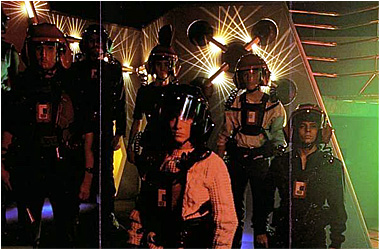
The most advanced laser tag system – till latest time it was commonly believed that the most advanced laser tag equipment was produced by Stunner (besides the other unique features, they used an electronic robotic gun that could be operated distantly – as an additional maze device). After Stunner’s shutdown, probably we can mention British DarkLight V.5, Australian LaserForce Gen.6 and Delta Strike (New Zealand) as the most advanced laser tag systems in the world. In the picture below: DarkLight player (to the left) and LaserForce player (to the right).
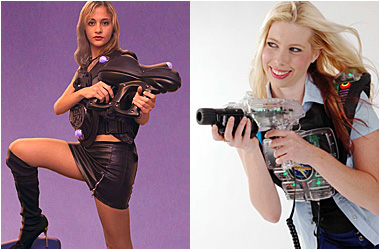
The most famous laser tag brand - is for sure Q-Zar, Earth’s beloved laser game. In spite of the fact that no single set of this equipment has been manufactured since the late 1990-s, this brand is still often used as a synonym for laser tag:
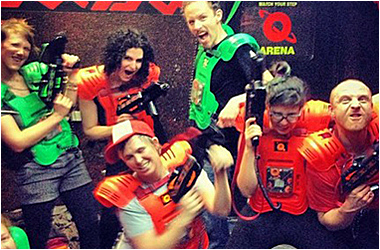
The biggest quantity of different types of laser tag systems produced by one and the same manufacturer - this record has been achieved by Zone Empire (founded by Australian P&C Micro), the current manufacturer and distributor of such systems as: Zone T, Infusion (marketed till autumn, 2010), Nexus, Nexus PRO, Begeara, Zone Skirmish (outdoor system), Hangar 51 (distributor). Besides, this company introduced rather a wide range of laser tag brands: DarkZone, MegaZone, Zone Laser, Zone 3, Zone 4 (though all of them are used to name one and the same system, yet in different countries). In the picture below: a MegaZone player.

The biggest number of modern laser tag systems inspired by one and the same system - is probably 4; all of them being inspired by Actual Reality (which is out of production at present time). In the picture below: advertising poster issued by Actual reality arena in Swedish Stockholm (now the system there was changed).
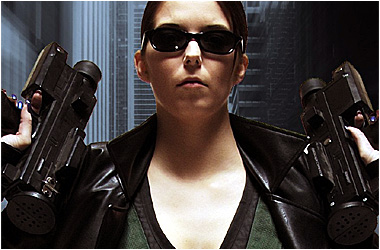
The greatest number of players simultaneously participating in one laser tag game – is 436; this record was achieved in January, 2013 at a BattleField Sports' site in Australia. The previous record (2008) was 279 players, and the 'official' Guinness Book Record is 250 only. At the picture below: a BattleField Sports player holding a Combat Rifle M16/A2/M203:
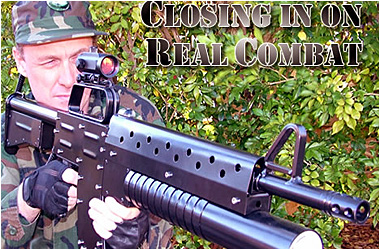
The oldest laser tag arena (as per 2013) – is LaserForce site in Brisbane, Australia, which celebrated its 25th Anniversary in January, 2013. At this, LaserForce is also regarded as the oldest laser tag manufacturer active till present. At the picture below: players wearing LaserForce Gen7 equipment:

The largest laser tag maze in Europe (as per 2012) – is, probably Dutch Silverstone Lasergames (LaserMaxx system) at Zwanenburg with a 1500 sq.m maze:
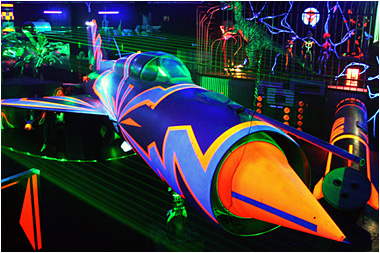
The biggest laser tag arena in Europe with two or more mazes (as per 2012) - is the opened in spring, 2010 LaserZone in Bradford, United Kingdom. The 1670 sq.m' arena is equipped with ZetaBlast (Laser Blast) laser tag system for 40 players and has a multilevel maze themed after Resident Evil movie (see the Red Queen and the Laser Corridor at the picture below):
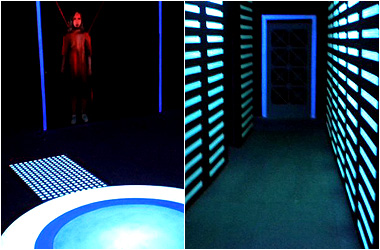
World's largest indoor laser tag site (as per 2012) - is LaserMaxx Wien arena (LaserMaxx Evo-5 system) in Vienna, Austria with indoor playing zone of 2500 sq.m (the previous record belonged to US Hard Knocks in Orlando, with 2200 sq.m of playing grounds; 2010-2012). At the picture below - part of the playing zone of LaserMaxx Wien:
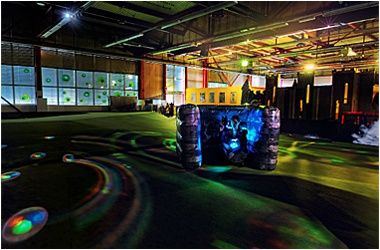
The heaviest laser tag phaser (as per 2012) – probably the first place here can be shared between heavy machine gun phazer Gattling Gun produced by American Zone Skirmish and Cannon phazer produced by Australian BattleField Sports. In the picture below: Gattling Gun (upper left corner) and Cannon (mounted on the motor boat).

The biggest quantity of different types of phasers has been produced under LaZer Tag brand by Worlds of Wonder and (later on) by Tiger Electronics (so called consumable laser tag equipment). In the picture below: an advertising poster of DeLuxe laser tag set by Tiger Electronics.
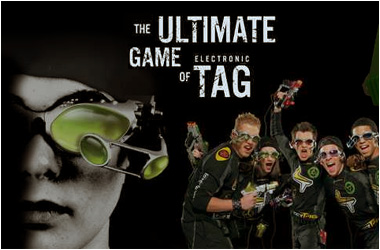
The most tasty laser tag pack - a birthday cake in a form of Delta Strike laser tag pack was made in 2010 by Judy Dubois for her son Westley's party at AlfaStrike Laser Tag and Arcade (Dartmouth, Canada). In the picture below: the birthday cake.
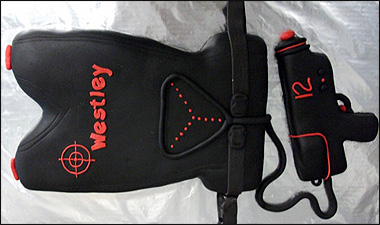
:: NIS and Baltic countries ::
The first laser tag site to be opened in the ex-USSR was a Q-Zar arena in Minsk, Belarus. The site was opened in 1995 and closed in the late 1990-s.
The oldest laser tag site in the ex-USSR that is still in operation is LaserMaxx (former Q-Zar) arena in Roll-Hall FEC, Moscow. In the picture below: Roll-Hall FEC at night.

The most popular laser tag site in the ex-USSR (as per 2010) – was Quasar Elite arena at Lider FEC, St.-Petersburg. Equipped with 40-vest system, this arena was so popular that the operator had to divide the players into four leagues with the aim of managing the playing time. In the picture below: a player is attacking head-quarters in the maze of Lider arena:
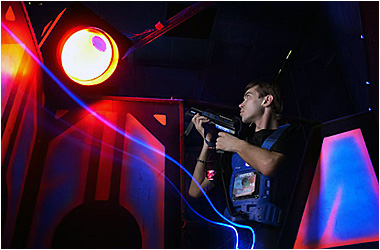
The most non-typical laser tag site in the ex-USSR - was BaZa arena in Almaty, Kazakhstan. They used Laser Mania system, which is rather rare in Europe. Besides, the phazers used at this site had undergone some special modification thus possessing unique look. In the picture below: a BaZa arena’s player holding the unique Laser Mania phazer:
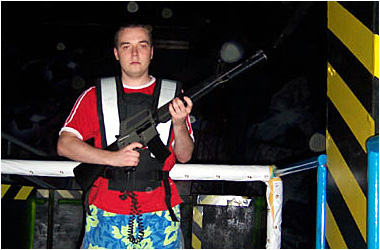
The highest price for a laser tag game – was charged at Q-Zar arena in KartLand FEC in Moscow (was closed in late 2006). For a standard 15-minutes’ game the players had to pay about USD 20 per person.
The most expensive laser tag site in the ex-USSR (as per 2010) – is probably equipped with LaserTron system Game Zona arena at Warsaw Express FEC in St.-Petersburg. The approximate price of building and equipping of this arena could be more than USD 300 per square meter. In the picture below: maze of Game Zona arena.
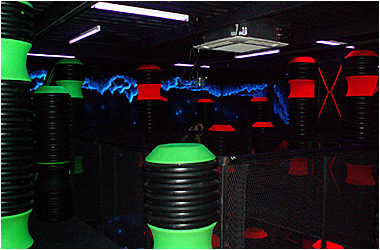
The biggest laser tag maze in the ex-USSR (as per 2012) – is the 750 sq.m maze of Giperboloid arena in Kiev (they use 30-vest LaserMaxx system there). The maze is equipped with a three-storey installation simulating a tower. In the picture below: central part of the maze of Giperboloid arena:
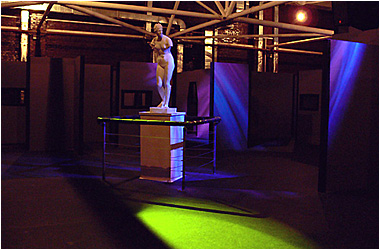
The most impressive laser tag maze (as per 2010) – is probably the maze of Bowlero arena (equipped with LaserMaxx system) in Riga. Decorated with artistic 3D-effects and sculptural installations, it makes an unforgettable impression on every visitor. In the picture below: part of the maze of Bowlero arena:
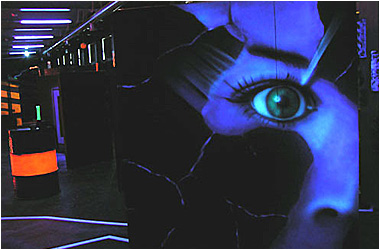
The simpliest laser tag maze (as per 2012) - was the maze of Venski Dom arena (Ataka system) in Kharkov, Ukraine (closed by now). It consisted of metallic shanks and cloth panels tight to them.
The first two-level maze to be opened in the ex-USSR – was the maze of Igromax arena (Q-Zar system) in Moscow, operated in 2005-07. In the picture below: the second floor of the maze.
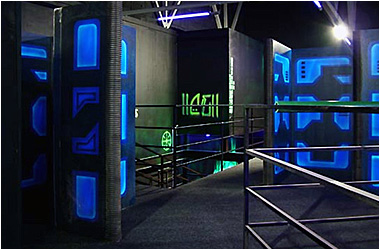
The first commercial outdoor laser tag system to be produced in the territory of the former Soviet Union – is Latvian Specnaz system. They started development of the system in 2002 and the first commercial set of equipment was produced in 2003. In the picture below: Specnaz players.

The most prevalent outdoor laser tag system in Russia (as per 2010) - is Russian-made Poligon 64: they have at least 46 confirmed active operators that joined Poligon network (by the end of 2010 and according to the information provided by the Manufacturer), plus some other sites using their equipment (up to 40), as well. In the picture below: Poligon 64 players:
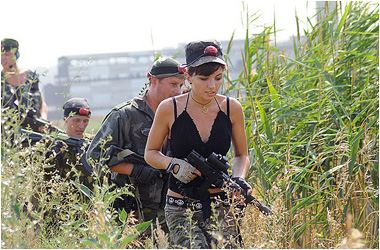
The most formalized laser tag game rules have been introduced at Quasar Elite arena in Lider FEC in St.-Petersburg. Actually they were used by regular players. There were more than 30 articles in the official edition of them.
The hardest style of laser tag playing was practiced at Start arena (Q-Zar system) in Kiev (the site was closed in 2000). There, it was allowed to run, to push the opponents (as they do in ice hockey), to cover the side hit sensors of the phazers and to even shift the maze elements during the game.
The first laser tag totalizator was introduced in November, 2002 at Seven Stars arena (Q-Zar system) in Krasnodar: during the arena championship the visitors were allowed to gamble on the Winner.